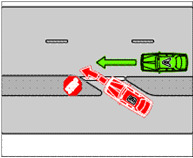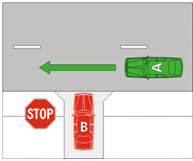 Australian Capital Territory Numbered Regulations
Australian Capital Territory Numbered Regulations Australian Capital Territory Numbered Regulations
Australian Capital Territory Numbered Regulations(1) A driver approaching or at a place with a stop sign or stop line must stop and give way in accordance with this section, unless the place is—
(a) an intersection; or
(b) a children's crossing; or
(c) an area of a road that is not a children's crossing only because it does not have—
(i) children crossing flags; or
(ii) children's crossing signs and twin yellow lights; or
(d) a level crossing; or
(e) a place with twin red lights.
Maximum penalty: 20 penalty units.
Examples
1 a stop sign at a break in a dividing strip dividing the part of the road used by the main body of moving vehicles from a service road
2 a stop sign on an exit from a car park where the exit joins the road
(2) The driver must stop as near as practicable to, but before reaching—
(a) the stop line; or
(b) if there is no stop line—the stop sign.
(3) The driver must give way to any vehicle or pedestrian at or near the stop line or stop sign.
Example 1
Stopping and giving way at a stop sign at a break in a dividing strip

In this example, vehicle B must stop and give way to vehicle A.
Example 2
Stopping and giving way at a stop sign where a car park exit joins a road

In this example, vehicle B must stop and give way to vehicle A.